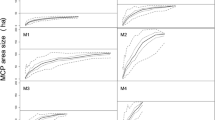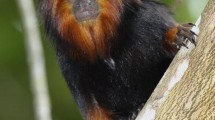Summary
Bowerbirds (Ptilonorhynchidae) have been described as exhibiting exploded lek mating patterns. Quantitative documentation and analysis of spatial dispersion, however, is lacking for most species despite its importance to a fundamental understanding of social organization. We studied Macgregor's Bowerbird (Amblyornis macgregoriae) in eastern New Guinea in 1980 and 1981 to quantify spatial distribution and selection of bower sites in relation to ecological and social factors. Forty-two bower sites were located in approximately 750 ha of mid-montane forest. They were linearly and regularly spaced along ridges with a mean inter-bower distance of 169±64 m SD (range 75–348 m). Statistical analysis showed males to be regularly spaced within available habitat. Discriminant analysis of seven habitat variables measured along utilized ridge lines showed that bower sites differed significantly from potentially available sites with respect to slope and width of ridge, closure of canopy, and density of saplings. Placement of bowers with respect to these factors was not correlated with inter-bower distance. Most males maintained only one bower; four (10%) maintained two bowers simultaneously. Males spent an average of 54% of daylight hours within an activity center of 15–20 m radius surrounding the bower and aggressively defended this area against conspecific males. Marauding pressure on bowers was high, and 39% of all observed mating attempts (n=18) were disrupted by neighboring males. Macgregor's Bowerbird exhibits a social system that appears to be intermediate between lek behavior and territoriality, combining the social dynamics and opportunism of the former and the uniform field of display sites and nests of the latter. We hypothesize that dispersion in this species is partly due to males buffering their display space against intruder pressure. We suggest that strict adherence to the dispersion criterion in classifying promiscuous mating systems may be inappropriate.
Similar content being viewed by others
References
Alexander RD (1974) The evolution of social behavior. Annu Rev Ecol Syst 5:325–383
Altmann J (1974) Observational study of behavior. Behaviour 49:227–267
Bell HL (1972) Altitudinal distribution of the bowerbirds of the genus Amblyornis. Emu 72:34
Bendell JF, Elliot PW (1967) Behavior and the regulation of numbers in Blue Grouse. Can Wildl Serv Rep No 4
Bradbury JW (1981) The evolution of leks. In: Alexander RD, Tinkle D (eds) Natural selection and social behavior, Chiron Press, New York, pp 138–169
Bradbury JW, Vehrencamp SL (1977) Social organization and foraging in emballonurid bats. III. Mating systems. Behav Ecol Sociobiol 2:1–17
Brown JL, Orians GH (1970) Spacing patterns in mobile animals. Annu Rev Ecol Syst 1:239–262
Cooper WT, Forshaw JM (1977) The birds of paradise and bower birds. Collins Press, Sydney
Crook JH (1964) The evolution of social organization and visual communication in the weaverbirds (Ploceinae). Behaviour [Suppl] 10:1–178
Crook JH (1965) The adaptive significance of avian social organization. Symp Zool Soc (Lond) 14:181–218
Crockett Wilson C (1977) Methods of observational research in the zoo setting. In: Crockett Wilson C, Hutchins M (eds) Applied behavioral research. Pika Press, Seattle
Diamond JM (1972) Avifauna of the eastern highlands of New Guinea. Publ Nuttal Ornith Club 12, Cambridge, MA
Donaghey RH (1981) The ecology and evolution of bowerbird mating systems. PhD dissertation, Monash University, Victoria, Australia
Ellison LN (1971) Territoriality in Alaskan Spruce Grouse. Auk 88:652–664
Frith CC (1970) Sympatry of Amblyornis subalaris and A. macgregoriae in New Guinea. Emu 70:196–197
Gilliard ET (1956) Bower ornamentation versus plumage characters in bower-birds. Auk 73:450–451
Gilliard ET (1963) The evolution of bowerbirds. Sci Am 209:38–46
Gilliard ET (1969) Birds of paradise and bowerbirds. Weidenfeld and Nicholson, London
Green RH (1979) Sampling design and statistical methods for environmental biologists. Wiley, New York
Gullion GW (1967) Selection and use of drumming sites by male Ruffed Grouse. Auk 84:87–112
Jarman PJ (1974) The social organization of antelope in relation to their ecology. Behaviour 48:215–267
Lack D (1968) Ecological adaptations for breeding in birds. Methuen, London
LeCroy M (1971) Sympatry in bowerbirds of the genus Amblyornis. Emu 71:143
MacArthur RH (1957) On the relative abundance of bird species. Proc Natl Acad Sci USA 43:293–295
Marshall AJ (1954) Bowerbirds: their displays and breeding cycles. A preliminary statement. Clarendon Press, Oxford
May RM (1977) Patterns of species abundances and diversity. In: Cody ML, Diamond JM (eds) Ecology and evolution of communities. Harvard Univ Press, Cambridge, MA, pp 81–210
Mayr E, Gilliard ET (1954) Results of the American Museum of Natural History expeditions to New Guinea in 1950 and 1952. Birds of central New Guinea. Bull Am Mus Nat Hist 103:311–374
Mayr E, Rand AL (1937) Results of the Archbold expeditions No 14. The birds of the 1933–1934 Papuan expeditions. Bull Am Mus Nat Hist 73:1–248
Nie HH, Hull CH, Jenkins JG, Steinbrenner K, Bent DH (1975) Statistical package for the social sciences, 2nd edn. McGraw Hill, New York
Orians GH (1961) Ecology of blackbird (Agelaius) social systems. Ecol Monogr 31:285–312
Oring, LW (1982) Avian mating systems. In: Farner DS, King JR (eds) Avian biology, vol 6. Academic Press, New York, pp 1–92
Paijmans K (1976) Vegetation. In: Paijmans K (ed) New Guinea vegetation. Aust Natl Univ Press and CSIRO, Canberra, pp 23–104
Peckover WS (1970) The Fawn-breasted Bowerbird (Chlamydera cerviniventris). Papua New Guinea Sci Soc Proc 21:23–35
Peckover WS (1972) Behavioral similarities of birds of paradise and bowerbirds to lyrebirds and scrub-birds. Papua New Guinea Sci Soc Proc 24:10–20
Pielou EC (1977) Mathematical ecology. Wiley, New York
Pielou EC (1981) The broken-stick model: a common misunderstanding. Am Nat 117:609–610
Pitelka FA, Holmes RT, MacLean SF (1974) Ecology and evolution of social organization in arctic sandpipers. Am Zool 14:185–204
Schodde R, McKean JL (1973) Distribution, taxonomy and evolution of the gardener bowerbirds Amblyornis spp. in eastern New Guinea with descriptions of two new subspecies. Emu 73:51–60
Sokal RR, Rohlf FJ (1969) Biometry. Freeman, San Francisco
Snow DW (1976) The web of adaptation. Demeter Press, New York
Vellenga RE (1980) Distribution of bowers of the Satin Bowerbird at Leura, NSW, with notes on parental care, development and independence of the young. Emu 80:97–102
Whitmore TC (1975) Tropical rain forests of the Far East. Clarendon Press, Oxford
Wiley RH (1974) Evolution of social organization and life-history patterns among grouse. Q Rev Biol 49:201–227
Wittenberger JF (1979) The evolution of mating systems in birds and mammals. In: Marler P, Vanderbergh J (eds) Social behavior and communication. Plenum Press, New York, (Handbook of behavioral neurobiology, vol 3, pp 271–349)
Author information
Authors and Affiliations
Rights and permissions
About this article
Cite this article
Pruett-Jones, M.A., Pruett-Jones, S.G. Spacing and distribution of bowers in Macgregor's Bowerbird (Amblyornis macgregoriae). Behav Ecol Sociobiol 11, 25–32 (1982). https://doi.org/10.1007/BF00297662
Received:
Accepted:
Issue Date:
DOI: https://doi.org/10.1007/BF00297662




